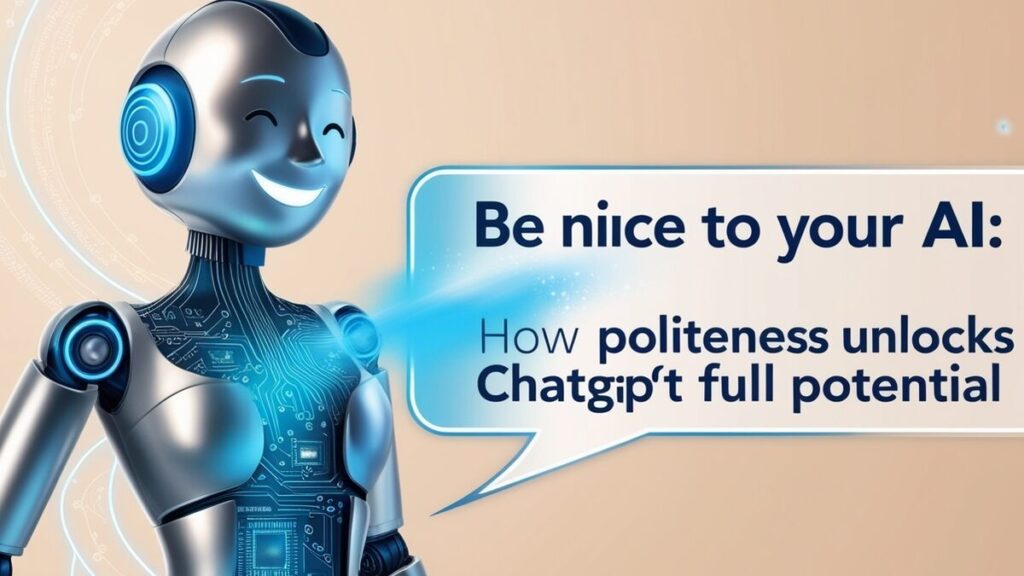Introduction
Artificial intelligence is revolutionizing how we interact with technology, making conversations with systems like ChatGPT natural and intuitive. But here’s a question: have you ever considered how your tone or phrasing might influence the outcome? While ChatGPT doesn’t have feelings, your approach directly impacts its performance. Being polite, specific, and respectful when using AI isn’t just good manners—it’s the secret to unlocking ChatGPT Full Potential.
- Introduction
- Why Politeness Matters in AI Interactions
- How to Use ChatGPT for Beginners
- How to Use ChatGPT Effectively for Writing
- How to Use ChatGPT on Mobile
- How to Use Chat GPT YouTube
- Practical Tips for Unlocking ChatGPT Full Potential
- The Science Behind Politeness and AI Functionality
- Examples of Polite vs. Impolite Prompts
- Politeness Unlocks Creativity
- Politeness and Its Role in AI Evolution
- Common Pitfalls to Avoid
- Conclusion
In this article, we’ll explore how a polite approach enhances your experience, ways to improve your interactions, and how AI responds to nuanced language. By the end, you’ll have a clear roadmap to get the most out of ChatGPT.
Why Politeness Matters in AI Interactions
Setting the Tone for Effective Conversations
Imagine starting a conversation with someone rudely or abruptly—chances it won’t go well. While ChatGPT isn’t human, it functions through natural language processing (NLP). Polite and structured queries improve the clarity of your requests, helping the AI interpret your intent more effectively.
For example, instead of demanding, “Write me a blog now,” try asking, “Could you please draft a blog about this topic?” The latter strategy fosters a constructive atmosphere and can increase the likelihood of receiving an excellent, contextually relevant response.
How Language Affects AI Outputs
Polite phrasing often leads to better-structured outputs because it helps define the AI’s contextual boundaries. Using proper grammar and courteous wording ensures ChatGPT understands your intent, unlocking its capabilities to their fullest. This refined approach allows the AI to generate responses that meet your needs.
Creating a Collaborative Environment
When you treat ChatGPT as a collaborative partner rather than a tool, you engage its programming in a way that mirrors mutual respect. Imagine working with a highly intelligent assistant who thrives on clear, positive communication. This shift in mindset can help you fully harness ChatGPT Full Potential.
How to Use ChatGPT for Beginners
Start with Simple Questions
For beginners, politeness and clarity are crucial. Instead of diving into complex tasks, start small. Ask ChatGPT: What has been said and not said about why resumes exist and what resume basics entail?” It is possible to gain more information about ChatGPT and a greater part of its functions by means of this systematic approach.
Learn Through Iterative Queries
Begin with one query, review the output, and follow up with additional clarifications. For example, could you explain more about the skill section, particularly when writing for software engineer?” enables the AI to replace the first reply to demands that it received while also enabling it to extend the reply.
How to Use ChatGPT Effectively for Writing
Set Clear Goals Before Starting
Politeness pairs well with specificity. Before typing your prompt, decide on your writing goals. Are you drafting a blog, creating an outline, or writing a story? Rather than asking ambiguous questions like “Help me write,” ask, “Can you compose a 1000-word blog post about the advantages of renewable energy for beginners?”
This approach ensures you leverage ChatGPT Full Potential and receive actionable, detailed responses tailored to your needs.
Revise Outputs Collaboratively
Use ChatGPT as a writing collaborator. If the initial output isn’t perfect, ask for revisions: “Could you rewrite the second paragraph to focus more on economic benefits?” AI gains the most when the encounters are repeated and in situations guided by accurate and gentle feedback.
How to Use ChatGPT on Mobile
Mobile-Friendly Prompts for Quick Results
Using ChatGPT on mobile allows for seamless productivity on the go. Shorter but polite prompts work well for drafting messages or brainstorming ideas. Never use this phrase: ‘Can you recommend themes for social media posts?” but instead provide the framework of “Can you please provide five amazing social media post ideas for a tech startup?”
Mobile Features for Flexibility
Leverage voice-to-text or copy-paste functionality on mobile. This makes it easy to interact with ChatGPT quickly and effectively, helping you achieve results faster while maintaining a polite tone.
How to Use Chat GPT YouTube
Generate Engaging Video Scripts
ChatGPT is perfect for creating YouTube content. Politely request specific formats: “Could you draft a YouTube script for a tech tutorial on setting up smart home devices?” This way, since the rule format implies engagement, it will be so if it is specific. As such, there are different programs from the AI noted above, the same.
Optimize Titles and Descriptions
Use ChatGPT to write titles and descriptions optimized for YouTube to maximize SEO. One example of a question to use while constructing a strong conclusion is, “Could you write an SEO-friendly title and description for a video on eco-friendly gadgets?” Politeness helps you communicate your goals effectively.
Practical Tips for Unlocking ChatGPT Full Potential
Start with Specific Prompts
Being polite is just the beginning. Specificity is key to getting the best responses. An ambiguous query such as “What can you do?” doesn’t provide enough context. Instead of, ‘Please do the following,’ try, ‘Could you assist me in writing an article of 500 words on the advantages of renewable energy?’
Specific prompts guide ChatGPT, ensuring its responses are on target. This combination of politeness and clarity forms a robust foundation for meaningful interactions.
Use Context-Rich Queries
Context aids the AI in giving more precise and beneficial responses. For instance, if you’re asking for travel tips, don’t just say, “Give me travel tips.” Instead, elaborate: “Could you provide tips for traveling to Europe in the winter with a focus on budget-friendly options?”
This approach enhances your interaction and ensures you tap into ChatGPT Full Potential.
Experiment with Creative Language
Engage with ChatGPT in a conversational style. Use friendly tones or experiment with metaphors and anecdotes to make your interactions dynamic. For example, instead of coming up with a phrase like “Explain AI,” you might come up with a question like “Can you explain AI as to how you would explain it to a child of 10 years”?
Politeness paired with creativity sparks responses that feel tailored and thoughtful.
The Science Behind Politeness and AI Functionality
Understanding ChatGPT’s NLP Mechanism
ChatGPT relies on NLP models trained to interpret various linguistic inputs. Politeness and proper structure help the AI process language patterns effectively, allowing it to generate coherent, contextually appropriate outputs.
Why Tone Influences Accuracy
AI systems analyze syntax and semantics. A polite tone often corresponds with structured language, which simplifies processing. This is like giving the AI a roadmap: It eliminates ambiguity, ensuring smoother and more accurate results.
Improving AI Learning Through Better Inputs
While ChatGPT doesn’t learn from individual interactions, its training data reflects diverse inputs. Your consistent use of polite, context-rich prompts indirectly reinforces the importance of respectful communication within its broader framework.
Examples of Polite vs. Impolite Prompts
| Impolite Prompt | Polite Prompt |
| Do my homework! | Could you help me solve this math problem, please? |
| Write an email! | Can you draft a professional email about this topic? |
| What is this? | Can you explain what this concept means in simple terms? |
Notice how polite prompts feel more structured and professional? This small change significantly impacts the quality of ChatGPT’s responses.
Politeness Unlocks Creativity
Better Storytelling Capabilities
ChatGPT generates more imaginative and engaging stories when you use politeness and context. Asking, “Write a story,” yields generic results, but saying, “Could you create a short story about a time-traveling chef?” generates original answers customized for your request.
Enhanced Problem-Solving
Whether brainstorming ideas or solving a technical issue, polite queries help ChatGPT focus on critical aspects of your request. A polite tone ensures the AI is ‘primed’ to deliver more thoughtful and precise solutions.
Customized Outputs
Politeness fosters an environment where the AI feels less transactional and more collaborative. This leads to outputs that feel uniquely tailored to your needs.
Politeness and Its Role in AI Evolution
Ethical AI Use
Using politeness isn’t just about improving outputs—it reflects responsible AI usage. Respectful interactions promote ethical standards in human-AI relationships, paving the way for technologies prioritizing user satisfaction.
Building Better AI Systems
Your polite interactions contribute to setting the benchmark for user expectations. Developers can use feedback to refine AI systems, ensuring they are responsive, intuitive, and capable of meeting diverse needs.
Cultivating Trust in AI
Being polite and engaging helps build trust in AI technologies. When people understand how to unlock ChatGPT Full Potential, they will likely adopt and rely on AI systems.
Common Pitfalls to Avoid
Overloading the AI
While ChatGPT is powerful, bombarding it with lengthy, unclear prompts can slow its processing. Therefore, keep your requests polite but concise.
Ignoring Context
Skipping context reduces output accuracy. Always include essential details to ensure clarity.
Using Ambiguous Language
Vague queries can lead to irrelevant responses. To get the desired result, be kind yet explicit.
Conclusion
Politeness might seem trivial when interacting with AI, but it’s the cornerstone of unlocking ChatGPT Full Potential. By combining respect, clarity, and context, you enhance the AI’s ability to meet your needs efficiently. From better storytelling to efficiency in problem-solving, polite interactions create a collaborative environment where ChatGPT thrives.
At the same time, it might seem like a small change, but adopting a respectful tone when using AI is a simple yet transformative step. Treat ChatGPT as more than a tool; consider it your collaborative partner. So, the next time you ask ChatGPT for assistance, remember that politeness isn’t just about being nice—it’s about unlocking its full potential to provide clear, precise, and engaging responses. With this mindset, your interactions will become smoother, more effective, and ultimately more rewarding.


